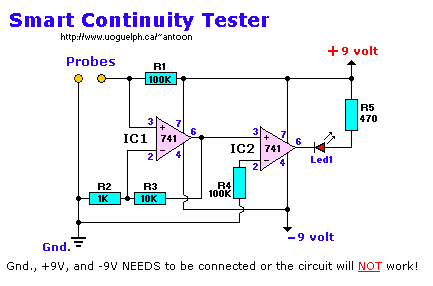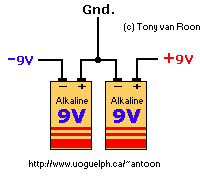
Parts List:
R1 = 100K Led1 = Your choice. I used High Brightness LED, RED, 5mm
R2 = 10K IC1,IC2 = LM741, Op-Amp
R3 = 1K Two 9 volt Alkaline batteries, case, probes
R4 = 100K
*R5 = 470 ohm (see text)
How it works:
Occasionally you need a continuity test between two points in an electronic circuit. Unfortunately, most continuity
testers are prone to "lie". They don't do that deliberately, but if they see a small resistance, they still
tell you that you have continuity. They just don't know any better.
This unit is different. If you have continuity it will tell you so. And if you're reading even a low resistance
through a component, the unit will tell you that as well.
The unit uses two LM741 op-amps. It offers a short-circuit test current of less than 200µA. It detects resistance
values of less than approximately 3 ohms. Nicest of all, it will not break down a PN junction. Since then I have
long ago upgraded to the 'Latching' tester since it suits the type of work I do better.
In building this circuit, use good electronic practice, mounting the 741's in suitable ic sockets on perf-board.
While there's nothing critical here, keep the work neat, and leads nice and short. *If needed, reduce the value of R5
to 330 ohms if you are using an older type led. When you're done, mount the unit in a small plastic box. A small
dab of silicon rubber adhesive keeps the 9-volt battery in place at the bottom of the case, and will last a long time.
At the bottom of the page I have included the diagram how to connect the dual 9v power.
 Just in case you're just starting out in electronics, here is
how to get the -9, +9, and Gnd(Ground) connections.
Just in case you're just starting out in electronics, here is
how to get the -9, +9, and Gnd(Ground) connections.
A small hole with a grommet keeps the leads (probes) together. Another hole with a grommet holds the LED in place
on top of the box where it is plainly visible. This makes a nice one-evening project. Enjoy!
Caution:
There is no easy way to proof the unit against connection to the supply. Please, please be careful
if checking AC line wiring and switch off first. In a similar way, if checking electronic apparatus for unwanted
bridging between tracks, for instance or a suspected crack in a PCB (Printed Circuit Board) track switch
off power first also. Always practice good safety and think-before-you-do!

Back to Circuits Menu
Copyright © Tony van Roon>


 Just in case you're just starting out in electronics, here is
how to get the -9, +9, and Gnd(Ground) connections.
Just in case you're just starting out in electronics, here is
how to get the -9, +9, and Gnd(Ground) connections.